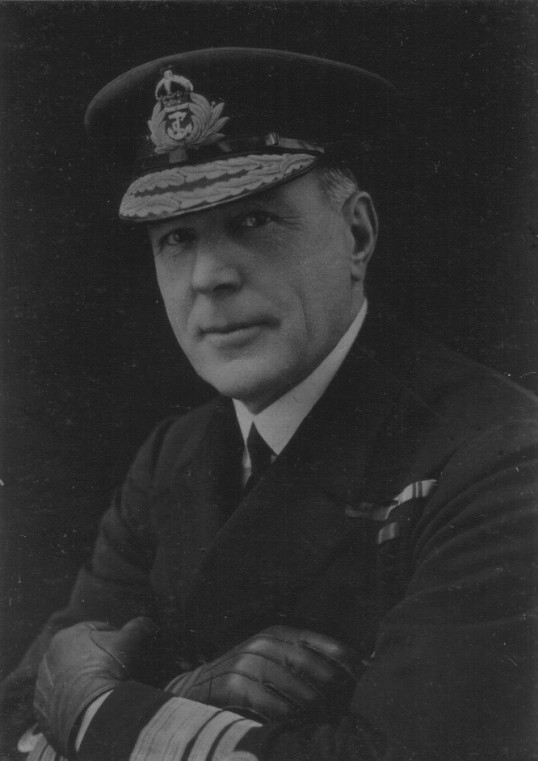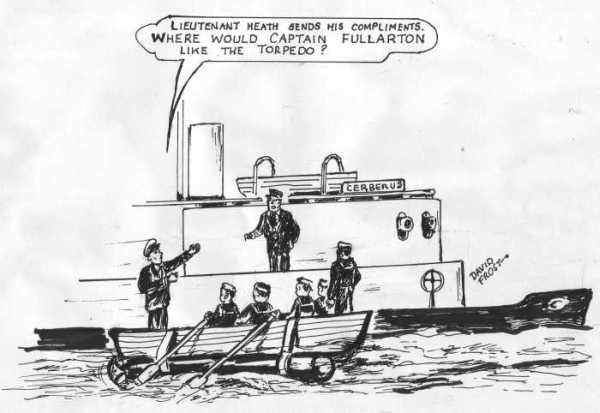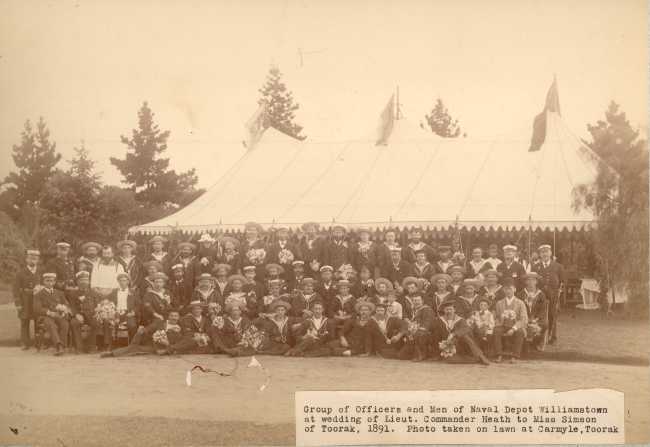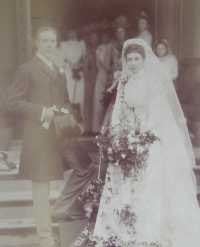| Herbert Leopold Heath
1861 - 1954
Lieutenant (RN)
Officer in charge of the Victorian Torpedo Fleet 1

The photograph & profile are from www.jjhc.info/heathherbert1954.htm
with permission of JJ Heath-Caldwell.
Admiral Sir Herbert Leopold Heath: An Overview
We know about Herbert from the following sources:
1. Entry in the book "Records of the Heath Family Vol 1" by George Heath, 1913.
2. Entry in the book "Records of the Heath Family Vol 2" by George Heath, 1920.
3. Mention in the book "The Kaiser" by Annika Mombauer and Wilhelm Deist, Chaper 7, by Matthew S Seligmann, published 2003.
The entry in Records of the Heath Family Vol 1, page 95, reads as follows:
Herbert Leopold Heath was born at Moorhurst, Holmwood, Surrey, Dec. 27th, 1861. After the usual home education by means of governesses, he went to Brighton College at the age of 10½, remaining there some 18 months. The idea of joining the Royal Navy was, for some reason, repugnant, although it was several times suggested. Herbert was then taken to Charterhouse School at Godalming, with a view to preparing him for a University education, for some unknown reason, the boy took a violent dislike to the look of Charterhouse, and announced that he would rather enter the Navy. There was little time to spare for preparation, but his father took his mathematics in hand, his mother the languages, drawing, etc., and a very excellent private tutor, Mr. Hook, of Dorking, carried out his instruction in other subjects, with the result that Herbert passed into the Britannia 6th of his batch. The interval between passing in and joining the Britannia was spent with his brother Gerard at the house of some old friends (Mm. Courtois) at Versailles, where he was thoroughly grounded in the French language.
In June, 1874, Herbert "put on his buttons," and joined H.M.S. Britannia, where in due cours, he became chief captain of his term, gaining a prize dirk on leaving, also the prize for physics and scripture. He was not particularly good at games, but won the sculling and sailing races for his term on two occasions. On leaving the Britannia, midsummer, 1876, he was appointed to H.M.S. Shah, about to be commissioned as Adm. de Horsey's Flagship on the Pacific Station. There appeared to be some suspicion as to the vessel's stability, for on the day following the commission, some wag put up a large notice to the effect that "Letter for H.M.S. Captain can be posted here," it being remembered that the Captain had foundered in the Bay of Biscay with all hands during the previous winter. Commissioning was somewhat rough work in those days, and it is noted the Herbert was laid up for two or three days, as a result of too much attention to new bread, ginger beer and raw rum. Owing to defective machinery, the Shah did not finally sail till just before Xmas. The Shah's commission was famous for her engagement with the Peruvian rebel ironclad Huascar, after a chase of four days, it being Herbert's good fortune to sight the chase during his afternoon's watch on the crosstrees.
The engagement lasted till dark, when the Huascar escaped, and surrendered next morning to her own government. As a result of this engagement, it was decided to replace the Shah (a composite vessel) by an ironclad, the Triumph being sent out, and all the midshipmen from Shah were transferred to her. Life in the Pacific seems to have been full of fun, and adventures plentiful, and at each port there appears to have been at least one particularly charming young lady. Amongst other places of special interest visits were paid to Honolulu, Pitcairn, and the Galapagos Islands. On reaching 19 years of age, Herbert passed in seamanship for the rank of Sub-Lieutenant, and was sent home, via Panama rail and Royal Mail S., as an acting Sub-Lieutenant.
A growing boy, after five years; absence, is naturally somewhat too big for the clothes in which he started, and it is said that on being met by his younger brother at the front door, he was promptly ordered round to the back premises for "bread and cheese," being mistaken for a common tramp. On completing the various examinations, Herbert was appointed Sub-Lieutenant to H.M.S. Northampton, flagship of Sir E. Commerell on the N. American and W. Indian Station.
The commission was uneventful, except for the ship twice getting on shore in Bermuda, and for a month or two there seemed to be a chance of war with Russia over the Penjdeh incident; it is sufficient to say that every Russian vessel was successfully shadowed by a British vessel of superior force. Promotion to Lieutenant came in due course, and after serving for one year in the rank, Lieutenant Heath was sent home by Mail Steamer to qualify for Torpedo Lieutenant. The Mail Steamer Hanoverian was wrecked off Cape Race during a thick fog, all hand were saved, but the baggage and cargo was lost, Lieutenant Heath, together with some other officers taking passage, received a letter of appreciation from their Lordships for their conduct on this occasion.
On completion of the Torpedo course, Lieutenant Heath was lent to the Government of Victoria as Torpedo Officer, under a three years engagement, terminating in January, 1891. Being then 29 years of age, he married at Melbourne, January 21st, 1891, Elizabeth Catherine, daughter of Colin Simson, Esq., of Mungadel, Hay, N.S.W., and returned to England immediately afterwards. His next service was as Torpedo-Lieutenant of H.M.S. Nile, newly commissioned for the Mediterranean under Captain Noel, one of the smartest Captains of his day. After one year's service, Lieutenant Heath was transferred to H.M.S. Victoria, flagship of Sir George Tryon, and was acting as Commander of that vessel when she was rammed by the Camperdown, June 23rd, 1893. The survivors were sent home in H.M.S. Triumph, and after a certain amount of leave, the majority of the officers commissioned H.M.S. Ramillies, to take the place of the Victoria; Lieutenant Heath again going as Torpedo-Lieutenant. He was promoted to Commander in 1896, and after a short spell was appointed Commander of the Battleship Camperdown in the Mediterranean a good portion of the commission being spent in Cretan waters during the troubles there prevailing, which ended in a massacre of a small body of the Highland Light Infantry, and the final occupation of Candia by British troops. Camperdown was paid off in 1899, and Commander Heath was, shortly after, appointed to H.M.S. Powerful, then lying in Simons Bay, the majority of officers and men being shut up in Ladysmith. Commander Heath was not landed on active service, and came home in H.M.S. Powerful early in 1900, and shortly afterwards was appointed to the Naval Intelligence Division of the Admiralty, when he was promoted to Captain as head of the War Division.
As Captain he commanded H.M.S. Vulcan, then H.M.S. Repulse, and finally H.M.S. Lancaster, the latter vessel being selected as one of the escorting cruisers during His late Majesty's cruise in the Mediterranean, including the return visit of King Alfonso. Captain Heath was awarded the Victorian Order, and Spanish Naval Order of Merit. After the two years commission of H.M.S. Lancaster, Captain Heath was appointed Naval Attaché to the Courts of Berlin, Copenhagen, and The Hague, during which time the competition in naval armaments became fully developed, and Germany's race for sea power was started in earnest. Captain Heath served in this post for two years, and was awarded the Order of the Red Eagle by the Emperor William.
On his return home in August, 1910, he was appointed to the command of H.M.S. Superb in the 1st Division of the Home Fleet, and was promoted to Rear-Admiral September, 1911, whilst in command of that vessel, receiving five months later the appointment of Admiral-Superintendent of Portsmouth Dockyard.
FAMILY OF H.L.HEATH AND HIS WIFE ELIZABETH CATHERINE SIMSON
MADELINE MARION, born at Malta, February, 1892
ROSAMOND ETHEL, born at Melbourne, October, 1893
The entry in Records of the Heath Family Vol 2, page 15, reads as follows:
ADMIRAL SIR HERBERT LEOPOLD HEATH, K.C.B., M.V.O.
Certain episodes in his earl career are worthy of notice.
During the voyage of H.M.S. Shah in 1876, she called in at Montevideo, where H.M.S. Volage was then lying. Her Captain challenged the Captain of the Shah to a sailing race as far as the Straits of Magellan, which was accepted. Six hours after making sail the Shah lost sight of the Volage astern. Thus ended the race.
His first appointment as Sub-Lieutenant was to the Training Brig Seaflower, where he spent the whole of the summer of 1882.
In 1884 he was shipwrecked in an Allan Line Steamer on his way home from H.M.S. Northampton, the ship being a total loss.
He had another fortunate escape whilst looking for a lost torpedo in Melbourne Harbour, the diver not being anxious to continue the search. After getting into the diving dress, he went down, got hold of the torpedo, and put a line round it, and then something went wrong with the gear. He just had sense to make the signal to be pulled up, but was unconscious on reaching the surface.
He was Aide-de-camp to His Late Majesty King Edward VII, and to His Majesty King George V., and took part in the Coronation ceremony of the latter Sovereign as A.D.C.
He held the appointment of Admiral Superintendent at Portsmouth Dockyard till October, 1915, when he proceeded to Scapa and hoisted his flag in H.M.S. Minotaur as Rear Admiral Commanding the then 7th Cruiser Squadron. In due course, the 7th and 2nd Cruiser Squadrons were amalgamated, and Admiral Heath took command of the newly constituted 2nd Cruiser Squadron; the whole of the Squadron took part in the battle of Jutland (awarded C.B. and mentioned in despatches). In September, 1916, he was given command of the 3rd Battle Squadron with the acting rank of Vice-Admiral, was appointed Second Sea Lord and Head of personnel on the Board of Admiralty, which position he retained until the end of March, 1919, when he was appointed Commander-in-Chief, Coast of Scotland.
He holds the following decorations:
British. K.C.B., M.V.O., Coronation Medal, South African Medal.
Foreign. Spanish Order of Merit, Grecian Order of the Redeemer, Prussian Order of the Red Eagle, Japanese Order of the Rising Sun, French Commander of the Legion of Honour, and Russian Order of St.Stanislaus, American Distinguished Service Medal.
The mention in the book "The Kaiser" Chapter 7, gives some notes regarding Herbert's time in Germany in 1910. He was the Naval Attache and had some difficulites with the Kaiser (as many other people also experienced at the time). For more information on this book visit the following:
http://titles.cambridge.org/catalogue.asp?isbn=0521824087
Born: at Moorhurst, Holmwood, Surrey 27 December 1861. Died 22 October 1954 at Stoneycrest Nursing Home, Hindhead, Surrey. He is buried at Holy Trinity Churchyard, Ebernoe, Sussex.
Son of: Admiral Sir Leopold Heath KCB RN and Lady Mary Emma Marsh.
Brother of:
1. Arthur Raymond Heath (1854-1943) who married Flora Jean Baxter.
2. Marion Emma Crofton (nee Heath, 1856-1949) who married Alfred Fox Cotton and then Richard Martin Crofton.
3. Maj Gen Frederic Crofton Heath-Caldwell (1858-1945) who married Constance Mary Helsham Heath-Caldwell (nee Helsham-Jones, 1869-1957).
4. Cuthbert Eden Heath (1859-1939) Insurance Businessman who married Sarah Caroline Gore Gambier.
5. Ada Randolf Broadwood (nee Heath, 1860-1957) who married HJT Broadwood (1856-1911).
6. Major-General Sir Gerard Moore Heath (1863-1929) who married Mary Egerton.
Leopold married: Elizabeth Catherine Simson (18??-1951).
Leopold and Elizabeth had issue:
1. Madeline Marion de Salis (nee Heath, 1892-1978) who married Capt Rodolph de Salis (1890-1972).
2. Rosamund Heath (1893-1970).
WHERE WOULD CAPTAIN FULLARTON LIKE THE TORPEDO?

"Lieutenant Heath sends his compliments to Captain Fullarton,
& would like to know where he would care to have the torpedo?"
drawing by David Frost
"Lieutenant Heath then went on to explain that he had obtained a man-o-war's gig, or an ordinary ship's boat similar in colour & design to the guard boats which were to surround the fleet & give warning of the approach of any of the diminutive & destructive launches under the lieutenant's command. Fixed to the keel of the gig was a torpedo to give it motive power, in addition to the oars used by the occupants of the boat.
While the men on the Cerberus had their attention occupied by the Nepean & the Childers, the gig stole quietly in upon the flagship approaching her from the stern. As had been anticipated by Lieutenant Heath those on the Cerberus who saw the gig coming towards the flagship merely regarded it as one of their guard boats that had met with a mishap & was coming on board to report the matter. The great pace at which the gig appeared to be rowed through the water, however, occasioned some surprise & admiration among those on the Cerberus; but they little dreamt that the propelling power was the torpedo & not the oars used by the men. One of the officers, probably with a view to obtaining the names of the rowers for the purpose of submitting them to the selectors of the next intercolonial eight oared race, or what is more probable for the purpose of knowing whom to select for a boat's crew to be matched against the next British or foreign man-o-war's crew coming into Port Phillip, walked along the stern of the flagship to meet the boat. As it drew alongside the Cerberus, enquiries were made as to what had happened. "Lieutenant Heath," replied the officer in charge of the gig "sends his compliments to Captain Fullarton, & would like to know where he would care to have the torpedo." "What's that?" exclaimed the officer of the Cerberus thoroughly bewildered. The message was repeated, & the officer in tones of surprise said, "But are you not one of our boats?" On receiving an answer in the negative he was not even then convinced and said, "But then where is the torpedo?" "Under the keel of the boat," was the reply. It was hurriedly explained to the commandant that a hostile boat with a torpedo had got alongside without even been suspected or challenged, & Captain Fullarton, apparently not caring to admit that he had been outwitted by Lieutenant Heath, claimed that hostilities had been commenced "exactly a minute and a half" before the stipulated hour, & therefore at the time of the attack the fleet was not ready to receive the torpedo boats."
The Argus, 7 April 1890
"Swagger" Wedding of the Season
What "Rhods," in Punch, calls the "swagger" wedding of the season - I am afraid the Australian colonists are developing a taste for slang - namely that of Miss Simpson with Lieutenant Heath, takes place on Wednesday next at St. John's Church, Toorak, when and where there will be a fashionable assemblage recalled for the most part from seaside resorts and summer residences situated at every point of the compass.
The Mercury (Hobart), 29 January 1891
Lieut. Heath, during his two year service, married the daughter of a very wealthy Riverina Squatter. The wedding took place at St John's Toorak, and the whole Victorian Navy were invited to the residence of the bride's parents in Toorak after the ceremony. At the church we unharnessed the horses - no motor cars in those days - and with drag ropes from the field guns dragged the happy couple through the streets. In the grounds of the home huge marquees had been erected for the entertainment of the troops - the tables simply groaned under the weight of champagne, wines, etc.
excerpt from Early Impressions of the Victorian Naval Forces, Lieutenant G. Prideaux, M.B.E., R.A.N. Spindrift October 1930

Men of the Victorian Naval Forces at the Wedding of Commander Heath and Elizabeth (Bessie) Catherine Simson on 21 January 1891.
Gunner John Blair standing on the far left with Gunner Cardigan Dann standing second from the left & Lieut. Heath seated third from left.
In the centre of the middle row, marked with an X is Chief Engine Room Artificer Charles Allard.
Photo courtesy of John Perryman, Senior Naval Historical Officer at the Sea Power Centre - Australia.
Click image for hi-res version
Melbourne.- On Wednesday, January 21, a very fashionable wedding took place at St. John's Church, Toorak, when Lieutenant Heath, son of Admiral Heath, of Holmwood, Surrey, was married to Miss Bessie Simson, of Carrugle (sic), Toorak. The decorations were exquisite; the flowers used being all pure white, with a large bouquet at each pew. The bride's dress was of satin duchesse, made with a long train, and edged with orange blossoms diamonds fastening the veil. The bridesmaids were Misses Bertha, Ethel, and Irene Simson; and her small nephew, Eric Fairbairn, acted as paqe, and was dressed in cream liberty silk; the bridesmaids wearing frocks of the same, with narrow lace frills, and carrying large baskets of scarlet carnations and maidenhair. Mr. Hanney and Captain Mann acted as groomsmen, and the Rev. Walter Fellowes performed the marriage ceremony. Among those present were Lady Clarke and Lady Constance Combe, Mrs. George Fairbairn, Mr. and Mrs. Septimus Miller, Captain Wallington, Mr. Ralston, Dr. Ryan, Mr. Arthur Blackwood, Mr. Chirnside, Colonel and Mrs. Rede, &c.
Australian Town & Country Journal, 31 January 1891

The Bride and Groom
Photo courtesy of www.jjhc.info/heathherbert1954wedding.htm with permission of JJ Heath-Caldwell.
Click image to enlarge.
Lieutenant Heath, who has been associated with the torpedo branch of the Victorian Navy for the past three years is a passenger for London per steamer Lusitania.
The South Australian Register, 9 February 1891
1 Williamstown Chronicle, 14 February 1891 |

